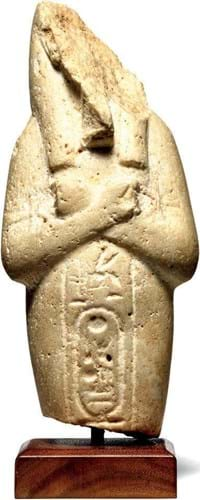The New Kingdom royal burial figure came for sale at Bonhams on July 6 from a vendor based outside the UK (and accordingly was subject to import VAT of 5% on the hammer price in addition to the buyer’s premium of 28%).
Nonetheless, it sold well above its £20,000-30,000 estimate for £65,000.
Radical reformation
As the pharaoh who introduced a radical religious and artistic reformation Akhenaten is among the most compelling fully documented figures from the ancient world. His 17-year reign from c.1352-1336BC during the 18th Dynasty marked an important break from tradition.
At the death of his powerful father Amenhotep III, he changed his name to Akhenaten, moved the capital from Thebes to the new city of Akhetaten (modern-day Tel el-Amarna) and substituted the traditional polytheism for a new monotheistic cult centred around the deified sun disc, Aten. He ruled with his wife, Queen Nefertiti.
The styles of that flourished under Akhenaten, known as Amarna art, are unique in the history of Egyptian royal art.
Expressionistic style
Representations are more expressionistic, exaggerated and stylised.
The often ‘unflattering’ portrayals of Akhenaten with a sagging stomach and broad hips are hinted at in this small and broken 7in (18cm high) carved limestone figure.
As discussed in The Royal Tomb at el-Amarna II (1989) by GT Martin, this shabti was probably part of the burial goods placed first in Akhenaten’s tomb in the Royal Wadi east of Akhetaten and later moved to the famous KV55 tomb in the Valley of the Kings.
It was last sold at auction at Sotheby Parke Bernet, New York, in 1974 and acquired by the vendor from the Bodo Bless (1940-2022) collection in Berlin.
Under Akhenaten’s successor, the boy king Tutankhamun led by the vizier Ay, Egypt gradually returned to its traditional polytheistic religion with Thebes once more the base of royal power.















